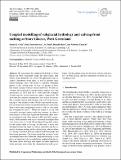Files in this item
Coupled modelling of subglacial hydrology and calving-front melting at Store Glacier, West Greenland
Item metadata
| dc.contributor.author | Cook, Samuel J. | |
| dc.contributor.author | Christoffersen, Poul | |
| dc.contributor.author | Todd, Joe | |
| dc.contributor.author | Slater, Donald | |
| dc.contributor.author | Chauché, Nolwenn | |
| dc.date.accessioned | 2020-03-13T09:30:03Z | |
| dc.date.available | 2020-03-13T09:30:03Z | |
| dc.date.issued | 2020-03-11 | |
| dc.identifier | 266865641 | |
| dc.identifier | c72a90b9-7f0d-4742-819c-d454bf4be800 | |
| dc.identifier | 85081930771 | |
| dc.identifier | 000519887600001 | |
| dc.identifier.citation | Cook , S J , Christoffersen , P , Todd , J , Slater , D & Chauché , N 2020 , ' Coupled modelling of subglacial hydrology and calving-front melting at Store Glacier, West Greenland ' , The Cryosphere , vol. 14 , no. 3 , pp. 905-924 . https://doi.org/10.5194/tc-14-905-2020 | en |
| dc.identifier.issn | 1994-0416 | |
| dc.identifier.other | Bibtex: tc-14-905-2020 | |
| dc.identifier.other | ORCID: /0000-0003-3183-043X/work/70619135 | |
| dc.identifier.other | ORCID: /0000-0001-8394-6149/work/70619159 | |
| dc.identifier.uri | https://hdl.handle.net/10023/19645 | |
| dc.description | This research has been supported by the European Research Council (RESPONDER (grant no. 683043)), the Natural Environment Research Council (grant no. NE/L002507/1), and the National Science Foundation (grant no. NSF OPP-1418256). | en |
| dc.description.abstract | We investigate the subglacial hydrology of Store Glacier in West Greenland, using the open-source, full-Stokes model Elmer/Ice in a novel 3D application that includes a distributed water sheet, as well as discrete channelised drainage, and a 1D model to simulate submarine plumes at the calving front. At first, we produce a baseline winter scenario with no surface meltwater. We then investigate the hydrological system during summer, focussing specifically on 2012 and 2017, which provide examples of high and low surface-meltwater inputs, respectively. We show that the common assumption of zero winter freshwater flux is invalid, and we find channels over 1 m2 in area occurring up to 5 km inland in winter. We also find that the production of water from friction and geothermal heat is sufficiently high to drive year-round plume activity, with ice-front melting averaging 0.15 m d−1. When the model is forced with seasonally averaged surface melt from summer, we show a hydrological system with significant distributed sheet activity extending 65 and 45 km inland in 2012 and 2017, respectively; while channels with a cross-sectional area higher than 1 m2 form as far as 55 and 30 km inland. Using daily values for the surface melt as forcing, we find only a weak relationship between the input of surface meltwater and the intensity of plume melting at the calving front, whereas there is a strong correlation between surface-meltwater peaks and basal water pressures. The former shows that storage of water on multiple timescales within the subglacial drainage system plays an important role in modulating subglacial discharge. The latter shows that high melt inputs can drive high basal water pressures even when the channelised network grows larger. This has implications for the future velocity and mass loss of Store Glacier, and the consequent sea-level rise, in a warming world. | |
| dc.format.extent | 20 | |
| dc.format.extent | 2928163 | |
| dc.language.iso | eng | |
| dc.relation.ispartof | The Cryosphere | en |
| dc.subject | G Geography (General) | en |
| dc.subject | DAS | en |
| dc.subject.lcc | G1 | en |
| dc.title | Coupled modelling of subglacial hydrology and calving-front melting at Store Glacier, West Greenland | en |
| dc.type | Journal article | en |
| dc.contributor.institution | University of St Andrews. Bell-Edwards Geographic Data Institute | en |
| dc.contributor.institution | University of St Andrews. School of Geography & Sustainable Development | en |
| dc.identifier.doi | https://doi.org/10.5194/tc-14-905-2020 | |
| dc.description.status | Peer reviewed | en |
This item appears in the following Collection(s)
Items in the St Andrews Research Repository are protected by copyright, with all rights reserved, unless otherwise indicated.

